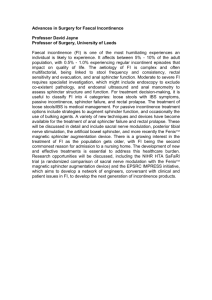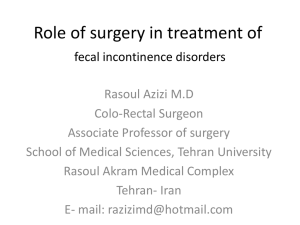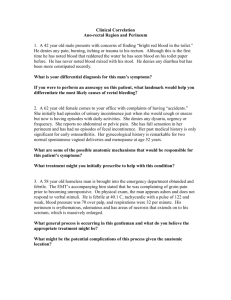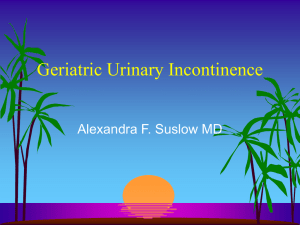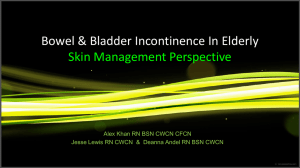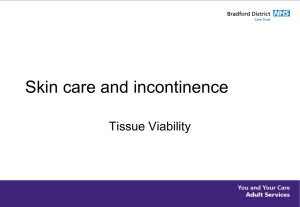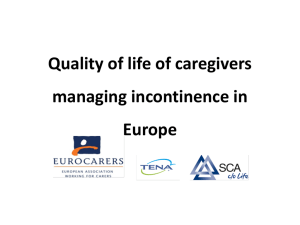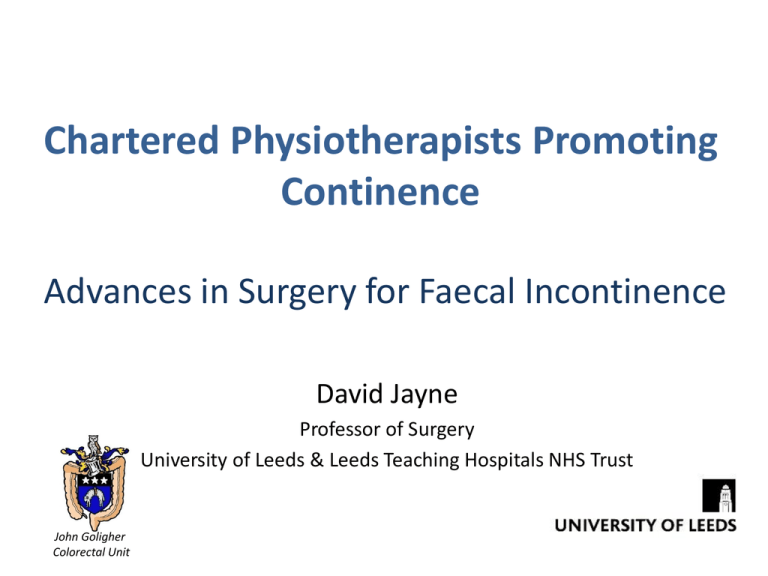
Chartered Physiotherapists Promoting
Continence
Advances in Surgery for Faecal Incontinence
David Jayne
Professor of Surgery
University of Leeds & Leeds Teaching Hospitals NHS Trust
John Goligher
Colorectal Unit
Faecal Incontinence
• One of the most humiliating experiences an
individual is likely to encounter
• FI is a sign or symptom, not a diagnosis
• Affects 1% - 10% of adults
• 0.5% - 1.0% experience regular FI affecting
quality of life
Faecal Incontinence
• Increasing incidence with age
• Population-based studies
– <40yrs: UI 9%; FI 5.3%
– > 60yrs: UI 19%; FI 9.7%
• Linked to urinary incontinence and pelvic
organ prolapse
– Risk of FI in patients with UI = 1.8
– Risk of FI in patients with UI + POP = 4.6
Pathophysiology
Complex, multifactorial aetiology
•
•
•
•
•
Stool frequency
Stool consistency
Rectal sensitivity
Rectal evacuation
Anal sphincter dysfunction
Terminology
• Faecal incontinence
– Incontinence of liquid or stool
• Anal incontinence
– Incontinence of flatus
• Urge Incontinence: loss of faeces due to
inability to suppress an urgency to defaecate
• Passive Incontinence: loss of faeces without
patient’s awareness
Patient Evaluation
• Patient centred approach considering
individual needs and preferences
• Detailed initial assessment
• Structured approach to management
• Address simple, reversible factors
• Specialist referral where appropriate
History
•
•
•
•
•
•
•
•
Frequency of incontinent episodes
Stool consistency – Bristol stool chart
Use of medications
Use of incontinent aids / pads
Impact on quality of life
Passive &/or urge incontinence
Surgical history
Co-morbidities
• Neurological conditions, spinal injuries, obstetric injury,
cognitive impairment, pelvic organ/rectal prolapse etc
Grading
Cleveland Clinic Incontinence Score (CCIS)
Never
Rarely
Sometimes
Usually
Always
Solid
0
1
2
3
4
Liquid
0
1
2
3
4
Gas
0
1
2
3
4
Pads
0
1
2
3
4
Lifestyle
0
1
2
3
4
Examination
• External appearance
– Patulous anus, Perianal scarring, Excoriation
• Digital rectal examination
–
–
–
–
Perianal sensation
Resting sphincter tone
Squeeze ability
Sphincter integrity
• Rigid sigmoidoscopy
– Exclude colitis, malignancy etc.
Investigation
• Colonic imaging
– Flexible sigmoidoscopy, colonoscopy
• Anorectal manometry
–
–
–
–
–
Resting pressure
Squeeze increment
High pressure zone
Vector profiles
Pudendal Nerve Terminal Motor Latencies (PNTML)
• Endoanal ultrasound
– Internal anal sphincter
– External anal sphincter
Anorectal Physiology & EAUS
AR Physiology
Normal values
• Resting pressure male 50 – 120 mm Hg
• Resting pressure female 30 – 100 mm Hg
• Squeeze pressure male 140 – 400 mm Hg
• Squeeze pressure female 75 – 250 mm Hg
• Volume first aware 10 – 30 ml
• Maximum tolerated volume 100 – 300 ml
PNTML
Endoanal Ultrasound Scan
Endoanal Ultrasound Scan
Endoanal Ultrasound Scan
Anterior sphincter injury
Anterior sphincteroplasty
AR Physiology & EAUS
• Sphincter defect
– Isolate EAS defect
– Isolated IAS defect
– Combined EAS & IAS defects
• Physiological function
– Ext. sphincter weakness consistent with EAUS
• Urge incontinence
• Co-existent pudendal neuropathy
– Int. sphincter weakness consistent with EAUS
• Passive incontinence
Classification
• Loose stools & IBS
• Passive incontinence
• Sphincter failure
• Rectal prolapse
Loose stool & IBS
• Defaecatory frequency with loose motions
• Typical individuals experience great anxiety
about leaving the house
• Worse in the morning
• Virtually never causes nocturnal incontinence
• More the individual concerned the worse the
problem
• Other IBS symptoms; otherwise healthy
Loose stool & IBS
• Overactivity of intestine – esp. colon in
response to normal factors that provoke
colonic contractions
– Getting up in the morning
– Eating
– Exercise
– Anxiety and stress
• Exacerbated by dietary factors –
– Very rarely due any true sensitivity
Loose stool & IBS
• Treatment
– Exclusion of serious pathology
• colitis, malignancy, coeliac disease etc.
– Explanation and reassurance
– Dietary/Lifestyle modification
– All aiming for more solid stool
• Antispasmodics e.g. Mebeverine
• Constipating agents e.g. Loperamide / codeine
• Bulking agents e.g. Fybogel
Passive Soiling
•
•
•
•
Unconscious seepage of soft stool
Occurs shortly after bowel movement
Leads to perianal skin irritation and itching
Men
• Direct result of soft stool which cannot be
expelled efficiently
• May occur in combination with obstructed
defaecation
Passive Soiling
• No evidence of weak sphincter – in fact longer
and stronger sphincter
• Mechanism is thought to be presence of a
small amount of stool within the lower rectum
• Triggers the RAIR – causes relaxation of the
internal sphincter
• Results in small amount of faeces in anal canal
which will leak out
Passive Soiling
• Aim of treatment is to achieve more complete
rectal evacuation
– firm up stool
– +/- suppositories, enemas
• In cases of IAS defect, anal key-hole deformity
– Consider IAS bulking agents
IAS Bulking Agents
Sphincter Failure
Accounts for about 5% of all cases
•
•
•
•
•
•
Obstetric Injury
Surgery
Trauma
Neurogenic / spinal cord lesion
Infection
Rectal Prolapse
Sphincter Failure
• Specialist evaluation is important to determine if a
surgically correctable cause is present.
• Obstetric and Prolapse most likely to benefit from
surgery
• Basic rule still applies:
KEEP THE STOOL SOLID AND THE RECTUM EMPTY
Treatment
• Conservative management
– Dietary modification
– Bulking and constipating agents
– Rectal enemas
– Irrigation techniques
– Biofeedback therapy
Rectal Irrigation
Treatment
• Surgical Intervention
– Anterior sphincteroplasty
– Sacral Nerve Modulation
• Posterior Tibial Nerve Stimulation
– Graciloplasty
– Artificial Bowel Sphincter
Anterior Sphincteroplasty
Identification of EAS/IAS
Mobilisation of EAS
Overlapping Repair
Perineal Reconstruction
Anterior Sphincteroplasty
Short-term results
• Reasonable
• 70% improved continence at 2 years follow-up
Long-term results
• Deteriorate with age
• 50% improved continence at 5 years follow-up
• Worse with:
– Large sphincter defect; multiple defects; atrophy;
pudendal neuropathy
Sacral Nerve Modulation
S2
S3
S4
Sciatic notch
Posterior Iliac Spines
Sacral Nerve Modulation
Test stimulation
•
•
•
•
•
S3 stimulation
Anal & toe response
2 weeks
Bowel diary
50% improvement
Sacral Nerve Modulation
Permanent Implant
• S3 implant
• Interstim buried in
buttock
• Remote programmer
Posterior Tibial Nerve Stimulation
Treatment Options
Complex 2nd line Surgery
• Stimulated gracilis neo-sphincter
• Artificial bowel sphincter
Stimulated Gracilis
• Gracilis muscle is mobilised
a/g wrap configuration is used
• Neurovascular bundle identified
• Chronic nerve stimulation coverts the fast
twitch muscle to a slow twitch muscle
• Requires defunctioning stoma during period of
adaptation
Artificial Bowel Sphincter
Magnetic Anal Sphincter Augmentation
Stoma
• Often considered treatment of last resort
• Better a continent stoma than an incontinent
bottom
• QoL often better
NIHR HTA Surgery call 2012
• Ideal opportunity to undertake rigorous
prospective evaluation of new technology
prior to widespread adoption in NHS
• Fenix MAS v SNS for treatment of adult faecal
incontinence
Objectives
• Short-term safety and efficacy of FENIX and
SNS
• Impact of FENIX and SNS on QoL and cost
effectiveness
Primary outcome
• Proportion of patients with FENIX or SNS in situ at 18months follow-up and with ≥50% improvement in CCIS
Secondary outcomes
• Length of stay
• Complications
• Re-interventions
• Consitpation
• QoL
• Cost effectiveness
Design
• UK, multi-centre, prospective, parallel-group,
randomised controlled, unblinded study
• 350 patients (randomised 1:1)
Eligibility
• Failed medical management
• Moderate to severe FI
– Incontinence > 6 months, suffering ≥2 incontinent
episodes per week
IMPRESS Network
Incontinence Management
and PRevention through
Engineering and ScienceS
ENTERIC Bowel Function HTC (London)
D4D HTC (Sheffield)
Colorectal Therapies HTC (Leeds)
Patients
Clinicians
Academic
Technology
Advocates
Academic Network:
Science +
Engineering
Expertise
IMPRESS plans
STAGE I - Learning and Information Exchange; Educating Scientists and
Engineers
- Technology advocates recruited. “Teachers” – to convey aetiology, physiology,
anatomy, biomechanics, biology and biochemistry of incontinence
STAGE II – Health Care Professional Shadowing
- Appreciate first hand the complexities and diversity of incontinence conditions
STAGE III – Patient Focus Groups
- A series of “exchange sessions” with patients
STAGE IV – Expanding the Network to Solve Problems – starting at month 12
STAGE V – Proof of Concept Projects
CONTACT: PROF ANNE NEVILLE a.neville@leeds.ac.uk
Summary
• Faecal incontinence: a common, underreported condition
• Multifactorial aetiology
• Careful patient-centred assessment
• Many causes simple and reversible
• Refractory cases referred for specialist opinion
• Expanding array of surgical options & research
opportunities
Chartered Physiotherapists Promoting
Continence
Advances in Surgery for Faecal Incontinence
David Jayne
Professor of Surgery
University of Leeds & Leeds Teaching Hospitals NHS Trust
John Goligher
Colorectal Unit

